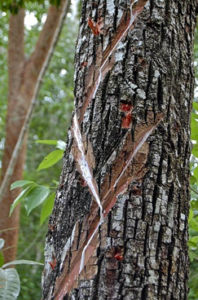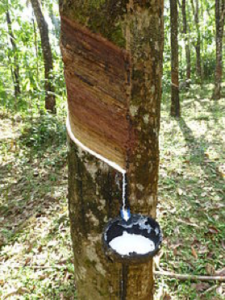Module 2: Values of Natural Forests: Harvested Products
Topic 2.2: Bark and Bark Products
Perhaps because it covers the outside of trees where it has to withstand fire, animal attack, wind sway, and a variety of other stresses, the barks of most tree species are typically extremely tough and often contain high concentrations of tannins and other defensive (=secondary) compounds. Throughout the world, bark fibers are or were used for binding, clothing, and in many other ways. Tannin concentrations in some barks can be as high as 40% by weight (e.g., Rhizophora spp.), and are used for curing animal hides to make leather. Other secondary compounds, such as salicylic acid from Salix spp. and tamanu oil from Calophyllum spp. are used to treat a wide range of human ailments. In fact, barks supply a large proportion of the natural medicines extracted from plants.
Although latex (= a complex emulsion of proteins, alkaloids, starches, sugars, oils, tannins, resins, and gums that coagulate on exposure to air) were historically and remain important NTFPs. The most famous type of latex today is rubber from Hevea brasiliensis trees native to South American but planted around the world, but others have been and remain commercial such as gutta percha from Palaquium spp. (Sapotaceae) trees, chewing gum from Manilkara zapote (chicle) trees, and jelutong from Dyera costulata (Apocynaceae). In some species latex is found in the pith or xylem, but it is most often extracted from bark. Latex is found under slightly positive hydrostatic pressures in long tubes called lacticifers. Living cells that surround the lacticifers produce the latex and keep it under positive pressure. The latex of many species is toxic, sometimes extremely so, and its natural function appears to be primarily related to protection of the tree from bark- and leaf-eating animals. In addition to being toxic, most latex is extremely sticky and mechanically interferes with their feeding.
Basic techniques for commercially harvesting latex from rubber trees without damaging the vascular cambium were developed nearly a century ago, although increasing labor prices and development of the market for Hevea wood have recently stimulated design of new methods. For other species, latex collection methods are more damaging as they usually involve cutting the bark with a machete from the entire bole and even large branches, such as for chicle harvesting from Manilkara sapote trees in Mexico and Central America (Figure 2.5). If the vascular cambium is not damaged, a tree can withstand latex harvesting for many years, but the associated losses of carbohydrates and other plant metabolites reduce its growth rate, fecundity, and possibly its resistance to pathogens and herbivores.


Figure 2.2. Harvesting methods for latex; chicle being harvested from a Manilkara sapote (chicosapote) tree in a dry forest on the Yucatan Peninsula of Mexico (left) and rubber being tapped from a Hevea brasilensis (Para rubber) tree in a Malaysian plantation (right).
